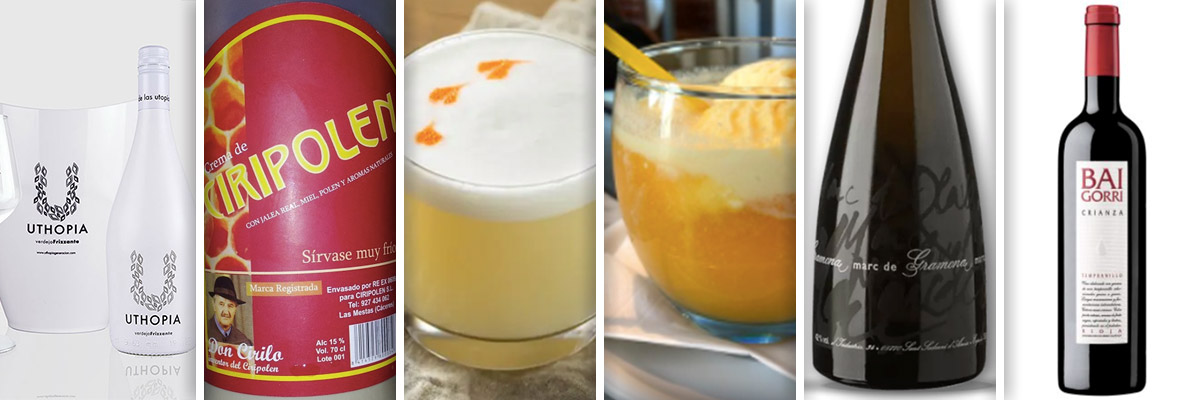So here we go with part 2 of my “Discover these drinks” series
I hope it is of your interest, and if you have any suggestions, contact me. Any input is appreciated.
Please note all prices are approximate.
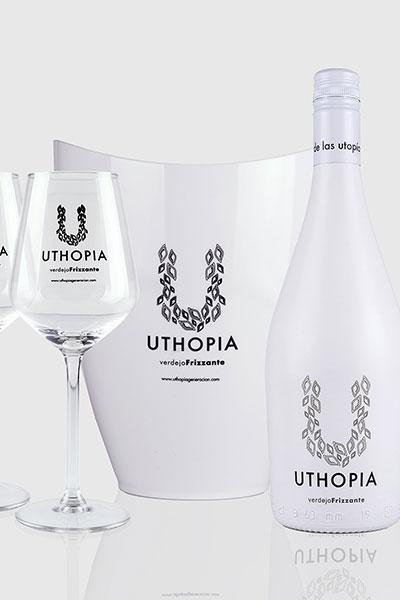
UTHOPIA Verdejo Frizzante, 5,5º
Uthopia has a low alcohol grade (5.5º), a fine bubble and is very easy to drink. It is light, elegant and with fine citrus notes. It is a serious contender as an alternative to sparkling wines or cava and stands out for its freshness (drink it very cold).
I saw the website and was captivated by the corporate image of this Verdejo Frizzante. …the bottle itself is a work of art. For just over 20 euros the Premium Pack Elegance (two glasses, an ice bucket and a bottle, all in white with the corporate image of the company) is the perfect gift. It reminds me a lot of the Osborne Brandy bottle from Salvador Dalí’s Centenary. The website inspires nights that never end. White, which is the dominant color, brings back many memories of Brazilian New Year’s Eve and Ibizan parties.
It reflects harmony and happiness. And part of the profits goes to charitable organizations. Congratulations to the creators of Uthopia.
Highly recommended.
Website: https://uthopiageneracion.com/
Price: 7-8 euros
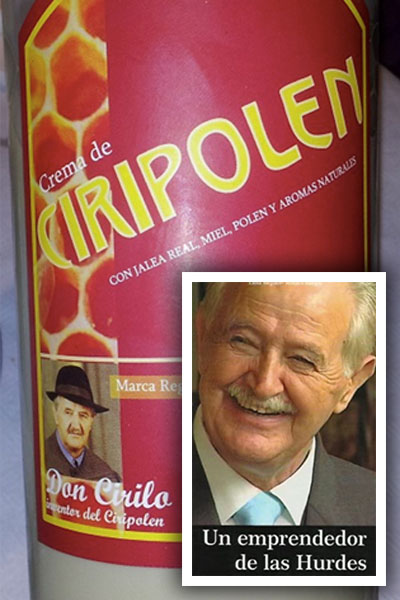
Ciripolen, “The miracle from the Hurdes”, 15º
Reflecting on this drink from the early nineties, many memories come to mind. There were special Ciripolen parties in Salamanca where everyone ran around overexcitedly with hardly any clothes on. Turns out that this concoction was supposedly an aphrodisiac and those who drank it felt the effects, even if it was all rather in their heads!
Then I saw the drink again on the Rayo Vallecano football shirts. I decided to go to Las Mestas, a town in the Hurdes region, on the border between Castilla y León and Extremadura of 21 inhabitants and 3 bars. One of these was a down-to-earth watering hole and who was behind the bar but the famous Cirilo himself. He explained that Ciripolen is made with milk, cac, many medicinal herbs, honey, royal jelly, and pollen. The bar is covered with photos of Cirilo at the Expo, on television talk shows and always surrounded by a large cast of celebrities…. even the King Emeritus and Felipe VI tasted the brew on site. Cirilo is a great character with many tales to tell of his visits to the Extremaduran markets where people saw him more as a sexual therapist than drink seller.
An American company wanted to buy the patent and with it the magic formula for its composition, but the entrepreneur from the Hurdes refused. Over time, its marketing has morphed from aphrodisiac to health drink.
The big problem over the years has been the drink’s sell-by date – as it contains fresh ingredients, this is pretty short.
In the end Cirilo decided to add alcohol which means you can keep it for much longer. Now it looks and tastes a lot like a Baileys-type liqueur.
Here you will find more information about Ciripolen and you can order it online.
Try it, it’s very good and very healthy.
And if you are in the Sierra de Francia, don’t miss out on a visit to Mestas and the Ciripolen bar.
Price: 10 euros
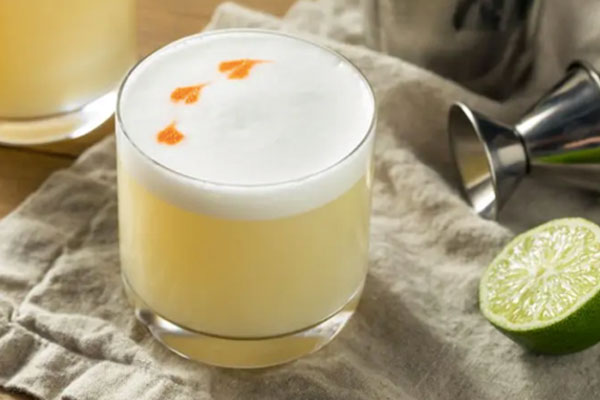
Pisco Sour, Chilean or Peruvian?
Is pisco Chilean or Peruvian? The question has been causing controversy in these two Latin American countries for decades. Some will say that it´s definitely Peruvian. Others will affirm, with the same conviction, that there is no doubt that it’s Chilean.
In Chile there are four official types of Pisco according to their proof: normal pisco 30º, special pisco 35º, reserved pisco 40º and Gran Pisco 43º.
Peru also has four types but they are classed according to their ingredients: pure pisco (of non-aromatic varieties), aromatic pisco (of aromatic varieties), mosto verde pisco and pisto acholado (a mixture of aromatic and non-aromatic varieties).
A great place to try pisco is Ceviche Bar/Restaurant in the London neighborhood of Soho:
https://andinaceviche.com/ceviche-peruvian-kitchen/
It has many great, old piscos.
Pisco, as the name of this drink already indicates, is the main ingredient for one of my favorite cocktails: the Pisco Sour
This is my recipe:
50 ml of pisco (I like the Demon of the Andes and not only because of its name)
50 ml of squeezed lime (if you don’t have lime you can add squeezed lemon)
1 egg white
2 tablespoons of white sugar
Throw everything into the blender with several ice cubes. If you prefer, you can do it in the shaker adding the same ingredients. Serve in a Martini cocktail glass and garnish with a few dashes of angostura bitters.
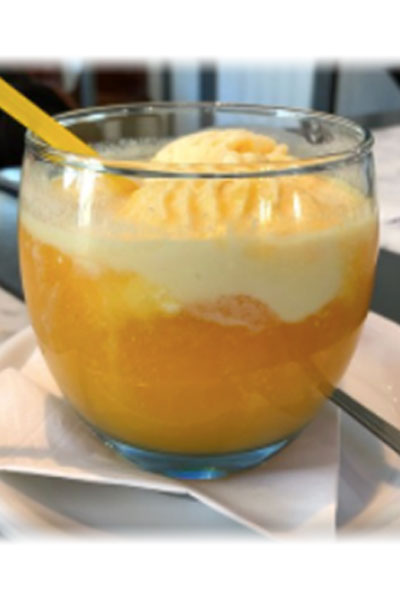
Valenciano, a refreshing dessert
I recently enjoyed a wonderful lunch at a restaurant in Plentzia (Vizcaya). When we got to dessert I suggested we had an Irish or Scottish coffee. No way. All my fellow diners were clear that we had to have a Valenciano.
I was a bit taken aback as I’d once had a drink called Agua de Valencia which was a little like sangria – alright but nothing to write home about.
But Valenciano was something else entirely: refreshing, not too alcoholic and not too sweet: I wouldn’t add sugar but if you have a sweet tooth (that’s what the English say) why not. No sooner had it been placed in front of me, than I got stuck in, which earned me serious reprimand from my expert eating friends who informed me that the ice cream had to melt a little first! Delicious!
To make a Valenciano you need the following ingredients:
1 scoop of vanilla ice cream, 1 glass of fresh orange juice, 1 generous splash of Gran Marnier or Cointreau (orange liqueurs).
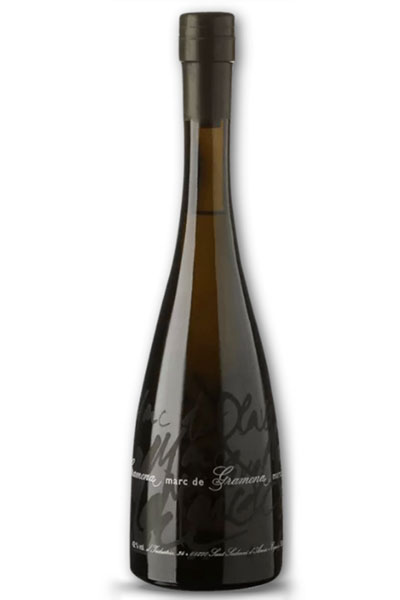
Marc de Cava Gramona, 42º
The Marc de Cava is a high-quality digestif usually enjoyed after meals serving. It is similar to pomace (Spanish grappa), but rather than coming from grapes, it is made from cava. By distilling a product that is already of high quality, you get something even more extraordinary.
To extract the marc you have to wait for the disgorgement of the bottle of cava. When this happens, a plug of frozen white liquid appears which contains the lees and the dregs. This plug of ice give the marc it’s special aroma. Once these plugs are collected, they are transferred to the still for the distillation process.
To make a bottle of Marc de Cava, between 80 and 100 bottles of cava are needed, at the very least. About 15 milliliters of marc can be extracted from each bottle of cava.
This sort of spirit is often harsh in the mouth and throat. Not so Marc de Cava which is much smoother than traditional pomace.
An ideal digestive with hints of thyme and lots of fruit.
Don’t miss it!
Price: 17 euros
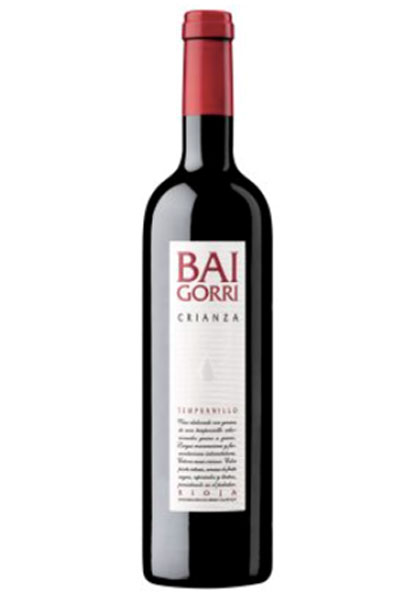
Baigorri, Crianza 2018, 14,5º
Baigorri is a bodega that I love. On arrival in Samaniego you are immediately aware that this is not just any winery. A seven-storey building carved into the rock, this is the Bodegas Baigorri project. Gravity is the leitmotif of this risky architectural project… and the wine-making process too.
The entire process is carried out by gravity, vertically, to preserve the integrity of the grapes as much as possible, which arrive whole for fermentation. All movements of grapes or wine are performed by gravity, avoiding any type of mechanical lift. Pumps are not used to transport the grapes.

Of the wide range of Baigorri wines, I would recommend the Crianza, which is fantastic value for money. 90% Tempranillo, 5% Garnacha and some native grapes from the Rioja Alavesa area. The aging phase lasts 14 months in French and American oak barrels. It has an intense cherry color and a mid-high layer. Aromas of black fruit and compote stand out.
The restaurant of this winery is another attraction. Enjoy the elegant tasting menu which combines local produce with wines from this bodega. The tasting menu includes a visit to the cellar.
Price: 12-13 euros

